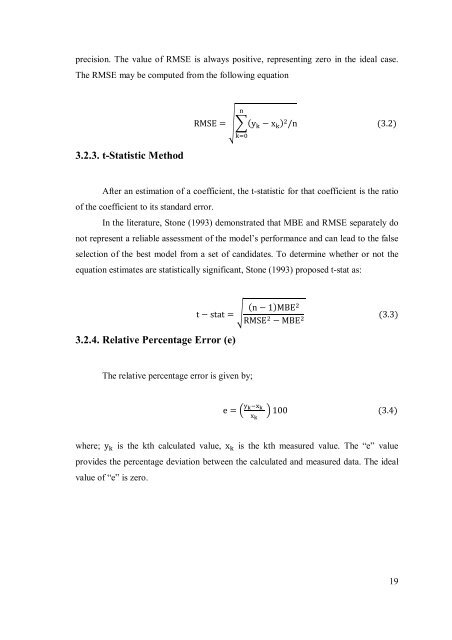measurement and comparison of solar radiation estimation models ...
measurement and comparison of solar radiation estimation models ...
measurement and comparison of solar radiation estimation models ...
Create successful ePaper yourself
Turn your PDF publications into a flip-book with our unique Google optimized e-Paper software.
precision. The value <strong>of</strong> RMSE is always positive, representing zero in the ideal case.<br />
The RMSE may be computed from the following equation<br />
3.2.3. t-Statistic Method<br />
<br />
RMSE = (y − x ) /n<br />
<br />
(3.2)<br />
After an <strong>estimation</strong> <strong>of</strong> a coefficient, the t-statistic for that coefficient is the ratio<br />
<strong>of</strong> the coefficient to its st<strong>and</strong>ard error.<br />
In the literature, Stone (1993) demonstrated that MBE <strong>and</strong> RMSE separately do<br />
not represent a reliable assessment <strong>of</strong> the model’s performance <strong>and</strong> can lead to the false<br />
selection <strong>of</strong> the best model from a set <strong>of</strong> c<strong>and</strong>idates. To determine whether or not the<br />
equation estimates are statistically significant, Stone (1993) proposed t-stat as:<br />
3.2.4. Relative Percentage Error (e)<br />
(n − 1)MBE<br />
t − stat = <br />
RMSE − MBE<br />
The relative percentage error is given by;<br />
e = <br />
<br />
(3.3)<br />
100 (3.4)<br />
where; y is the kth calculated value, x is the kth measured value. The “e” value<br />
provides the percentage deviation between the calculated <strong>and</strong> measured data. The ideal<br />
value <strong>of</strong> “e” is zero.<br />
19

















